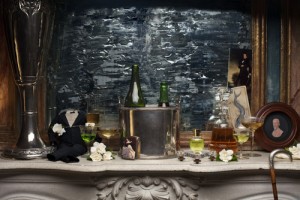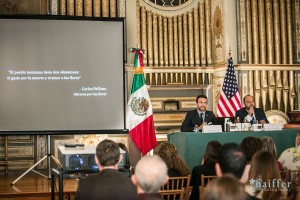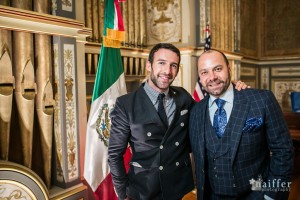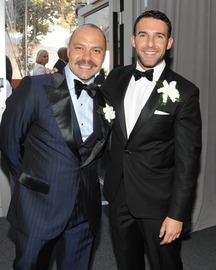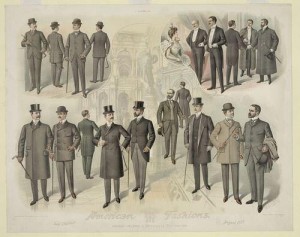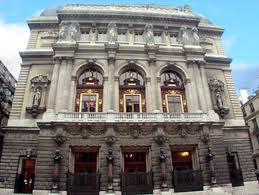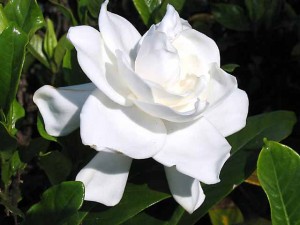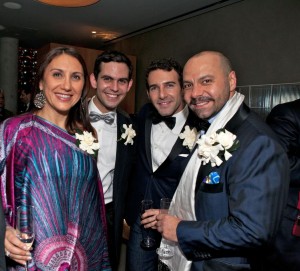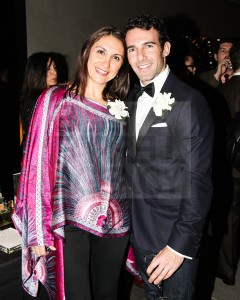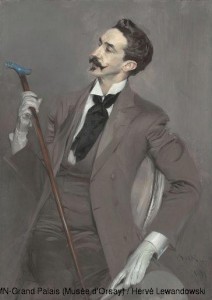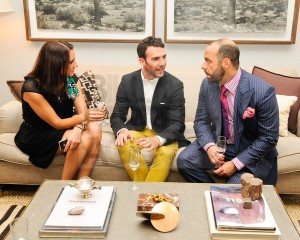Still Life for Arquiste Parfumeur Boutonniere No.7
One of the revelations of the past year for me is it is not just the perfumer who is responsible for putting the perfume in the bottle, although he or she might get the lion’s share of the credit. The best perfume houses are the result of a creative team which works together and more importantly challenges each other. Since meeting Carlos Huber soon after he launched the Arquiste Pafumeur line in 2011 I have been impressed with the creative quality on display in the inaugural six fragrances he released. The more I spoke with Mr. Huber the more I came to realize how much of a team effort the creation of those fragrances was between Mr. Huber, perfumers Rodrigo Flores-Roux and Yann Vasnier, and evaluator Sophie Bensamou. Upon the recent release of the seventh fragrance in the Arquiste line Boutonniere No. 7. I knew I wanted to see if I could get some insight into the creation of this process. Little did I realize two-thirds of the creative team was coming to me.
Carlos and Rodrigo at the Mexican Embassy 2012
At the end of October 2012 I found out that Carlos and Rodrigo were coming to the Mexican Embassy in Washington DC to speak on how their Mexican heritage played a role in the Arquiste Parfumeur fragrances. Rodrigo and Carlos took the stage and for an hour spoke eloquently about their Mexican roots and how that has influenced their life and their art. Rodrigo especially spoke on how he adds a bit of his homeland to every fragrance’, “Maybe I can cite a Mexican poet, Carlos Pellicer, who always praised the beauty of the Mexican tropics: the Mexican people have two obsessions: we are interested in death and we are in love with flowers. And as a Mexican flower lover, I always like to put a bit of Mexico in every perfume I make. It's not an accident I studied biology, specifically botany, and understand the secret language of flowers. It's also my last name!”
Carlos and Rodrigo at the Mexican Embassy 2012
After speaking with them at the reception I began an e-mail exchange with both of them on the creation of Boutonniere No. 7. I was interested to see how the roles of Carlos as Lead Project Manager and Rodrigo as Head Designer would mesh especially with Carlos’ experience as an architect. I asked Carlos what it took to go from “blueprint” to”construction” and he said, “Before starting the ‘construction’ of a fragrance, in essence, before starting to smell, I need to complete a ‘preliminary plan’: that is, to gather sufficient information to draw out a blueprint and understand ‘where’ (both in time and in space) this fragrance ‘project’ will take place.”
Rodrigo and Carlos at the FiFis 2011
The preliminary plan for Boutonniere No. 7 started at the Fifi Awards gala in 2011 as Carlos remembers that evening, “For a black-tie gala night last year, perfumer Rodrigo Flores-Roux bought gardenia boutonnieres for myself, Yann Vasnier, evaluator Sophie Bensamou and three other friends – us men wore them on our tuxedo lapels and the women in their hair. It was an exciting, happy night and there was much celebrating; lots of laughing and dancing. Towards the end, I noticed my gardenia boutonniere was crushed from all the hugging…its bright white gave out an extremely crisp scent that contrasted in its freshness with the heady, damp and smoke-filled atmosphere. It was floral of course, but in that context, its greenness seemed to me extremely masculine. If there is one scent that connects me to all the excitement of 2011 (the launch year for Arquiste) it is definitely the scent of that night out, and the uplifting crispness of that boutonniere.”
Men's Fashion circa 1899
Carlos then had to select a time period to go along with this idea and he chose fin de siècle Paris as his place, “During the Belle Époque, a man would select a fresh boutonnière in much the same way he would wear a freshly laundered shirt or a pair of polished shoes. Its glory laid in its fragility; it was picked, worn in the buttonhole and allowed to die. White flowers were generally preferred for Black-Tie dress because of their elegant, austere contrast against the black. Among these, gardenias were top choice since their scent would delight women as the gentlemen would draw them closer for a dance or an embrace.
The year 1899 is also a really evocative date; Paris is the World Capital, in very much the same way that New York has been and arguably still is…Modernity was advancing rapidly, and there was this electricity in the air that I think is very distinctive of transitional periods, such as the one we are living in right now.
Opera Comique, Paris
I visited the Opéra-Comique building in the beginning of the year and was really fascinated with it. It is a happier, more playful version of the Beaux Arts architecture you may find in other opera houses around the world. The polished parquet floors, huge light bulb chandeliers, smiling statues of women and Belle Époque frescos all have this ‘stimulating’ quality to them, as if they’re vibrating. One Saturday in May 1899, composer Jules Massenet premiered his light opera “Cendrillon” (Cinderella)…this moment represents both the golden age for the actual opera building, and for a culture based on the pursuit of beauty. I loved the positive and zingy atmosphere this place and this time evoked, and it connected so well with my own memory of that black-tie evening and the gardenia boutonniere I wore.”
As Carlos began to decide on who his head designer for this concept would be it seems obvious it had to be Carlos because it was his gardenia boutonnieres that started the creative process, “Rodrigo and I commented that very night on the vibrancy of the gardenias’ scent. I really liked how it complemented the fragrance I was wearing. After some initial research on the historical use of boutonnieres, I decided to pursue this as a new fragrance project and delve further. For the development, I decided to engage Rodrigo as ‘head designer’. He is so passionate about flowers, and has such talent for them AND for wonderfully refreshing, juicy citrusy fragrances, that I thought he would be the perfect ‘specialist’ for the style of this particular project.”
Gardenia
With concept and historical era in mind Carlos approached Rodrigo, his head designer, and of course the idea had been bouncing around his subconscious as well, “Actually, the gardenia concept had been mulling in both our minds for a while. Gardenias are very dear to me, they are one of my favorite flowers since I was a kid, I like them very much. Carlos can relate to this, being a fellow Mexican: they are popular cut flowers, and very frequently, they are sold in the streets, offered to by passers in small, compactly arranged bouquets. When you buy them, you are most probably driving and you can be sure that even the day after, the interior of your car will be redolent of that irresistible, green, gorgeous fragrance. And you already gave the bouquet to someone as a present!!
So, we thought of gardenias: but now the idea needed to have its "Arquiste" twist.
It's almost obvious that when Carlos and I are into perfume parlance, we mention, cite and evoke Marcel Proust (who doesn't?)… other characters, fictional or not come into the conversation as well: Baudelaire, Huysmans, Oscar Wilde, Reynaldo Hamm, Offenbach, Napoleon III, Lord Byron… even Emperor Maximilian of Mexico (!!!!). They are, arguably, the quintessential proto dandies. And their connection to a boutonniere is inevitable. Imagining this perfume at the Opera Comique became an easy task.”
Now it was up to Rodrigo to put the concept into concrete, the special nature of gardenia as both raw material and emblematic of Mexico made it critical to him to get this right, “Like I said before, I am crazy for that flower… and I also need to add that for perfumers, the scent of gardenias are somewhat of an "exercise de style", a complex theme to be approached emotionally and scientifically. It's a scent that has many layers and oddities. Replicating it is not as evident as working on a jasmine, or a peach or a vanilla theme, and perfecting it and then twisting it is not an easy thing. Gardenias are somewhat wild and raw, and you have to be careful not to domesticate the scent too much. The perfume must remain a bit unbridled. For a gardenia, the sharp green edge has to echo the milky, almost buttery sides harmoniously, and the animalic sides, which are both indolic and cresolic have to be very present as well. The descriptors "fruity", "ripe", "bitter", jasminic", "honey-like", "smoky" and "fungus-like" also come into play. Needless to say, the composition features a high amount of other floral extracts, namely jasmin concrete of the grandiflorum type and genet (broom flower) absolute, both mimetized into a white gardenia.”
Sophie Bensamou, Theodore Tsamados, Carlos Huber, Rodrigo Flores-Roux at Boutonniere No.7 Launch
It is at this point in our e-mail communication that we were all in New York for the opening of The Art of Scent exhibit and Carlos and Rodrigo introduced me to evaluator Sophie Bensamou. For those who don’t know what an evaluator does; it is her job to be the reflective surface so the head designer sees the truth of each version, like the mirror in fairy tales telling them their fragrance is not the fairest of them all, until it is. This is how Sophie describes her job, “Usually an evaluator does not suggest raw materials to a perfumer, we rather try to describe the crisp raw effect of cutting a raw mushroom, or the green luminosity of the violet leaf, the watery effect of a cucumber, the freshness of a citrus accord like in a cologne etc. We can also suggest some contrast and luminosity as in painting by Rembrandt, or talk about the delicate features of a Bernini sculpture (It is actually how I describe Rodrigo's style: He is the Bernini of perfumes! Always into delicate but statement making details)”
Rodrigo, Carlos, and Sophie share a special teamwork and she told me about her relationship with Rodrigo, “I have been developing fragrances with Rodrigo for 19 years now, so I guess we have a great communication and complicity, but it is very easy to work with Rodrigo; and I must add this concept suits him perfectly well.”
Sophie and Carlos
She also spoke of how she met Carlos, “Carlos and I became friends several years ago in Mexico City. We learned at the same time almost that we were both moving to NYC but somehow, we lost touch for a while. Then we met again after Yann Vasnier met Carlos by chance, and they talked about being a perfumer, Carlos said he had a friend Sophie who is a nose as well. Yann said: "Yeah! She sits next to me in the office. So we had lunch altogether! Then we introduced Carlos to Rodrigo and the rest is a love story!”
This love story still had some work to do in taking Rodrigo’s initial design and turning it into a finished project. Rodrigo recalls, “And this is where Carlos and Sophie played a super important role. Carlos was very clear he wanted the gender of this gardenia to be masculine, and Sophie kept the animalic dirty sides in check.” Sophie said about the animalic mod of Boutoniere No. 7, “We did have more animalic and dirty notes and through almost 20 years of collaboration, it has been about trying to find the right balance between Rodrigo's high tolerance and mine, quite lower I must admit, especially on cumin, civet and castoreum. But in fact, talking about cumin, I suggested it as a little wink, not only to the physicality of the flower but also to the warm moist skin of people dancing that night at the FiFi's party.”
Portrait of Robert de Montesquiou by Giovanni Boldini (1897)
It was Carlos who would get the project back on course with a suggestion according to Rodrigo, “It was Carlos' idea to dose in a healthy amount of bergamot essential oil of the best quality, and spike it with French lavender. The slight ketonic, mushroomy and herbal notes of lavender marry very well with a realistic gardenia theme. Since I was looking at BOTH the scents of Gardenia jasminoides (the 'traditional' gardenia) and also the citriodora species, (which basically features a true gardenia scent complemented with linalyl acetate, citral and citronellal), a masculine and refreshing introduction, almost cologne-like naturally happened. And to support it, a very pure vetyvert oil and a touch of real oak moss absolute also walked in: all of these pertain to classic masculine perfumery. I am pleased to say, that the result is dapper, elegant, assertive and just a tad disconcerting, an unusual perfume for a handsome man who also dresses beautifully.”
In response to my question on how long the process took I leave Rodrigo to sum it all up, “The process took almost a year. We tried many different things. At one point, the perfume was extremely animalic and dirty ( I do like those notes) but it scared some people. At another given moment, the gardenia tonality was drastically diminished and a headily dark leather/vetyvert accord took over… almost like a Cuir de Russie, enlarging the smoky tannin like accents of the flower. As interesting as it was, it just didn't seem right: the pristine flower scent seemed totally out of place, just as a man clad in a three piece suit would be amidst a crowd of bikers dressed in head to toe black leather. We organically returned to a true to nature floral scent, and very carefully, gave it a metamorphosis via an immaculate cologne undertone. I remember the sparkle in Carlos' blue eyes when we approached that finishing line. And some days later, after some little twists, he smiled his big smile; he shook my hand, gave me a hug and declared the opus "finita".”
Sophie, Carlos, and Rodrigo discussing No.8?
In hearing about the creative process between Carlos, Rodrigo, and Sophie I was struck at how often we give the credit to the perfumer but to truly create a piece of olfactory art it requires something similar to the “fuel/heat/oxygen” triangle which causes fire. In the case of Boutonniere No. 7 that triangle is “Creative Director/Perfumer/Evaluator” and together this triangle creates a fragrant fire that is very special indeed. Boutonniere No. 7 is one of the best fragrances released this year and after having Carlos, Rodrigo, and Sophie give me a glimpse into the entire process I am even more impressed.
My thanks to Carlos Huber, Rodrigo Flores-Roux, and Sophie Bensamou for allowing me to tell their story.
Thanks to the team at Arquiste Parfumeur we have a very special giveaway of a full bottle of Boutonniere No. 7. To be eligible leave a comment on the story about what you found most interesting. The draw will close on December 20, 2012.
We announce the winners only on site and on our Facebook page, so Like Cafleurebon and use our RSS option…or your dream prize will be just spilled perfume.
-Mark Behnke, Managing Editor

